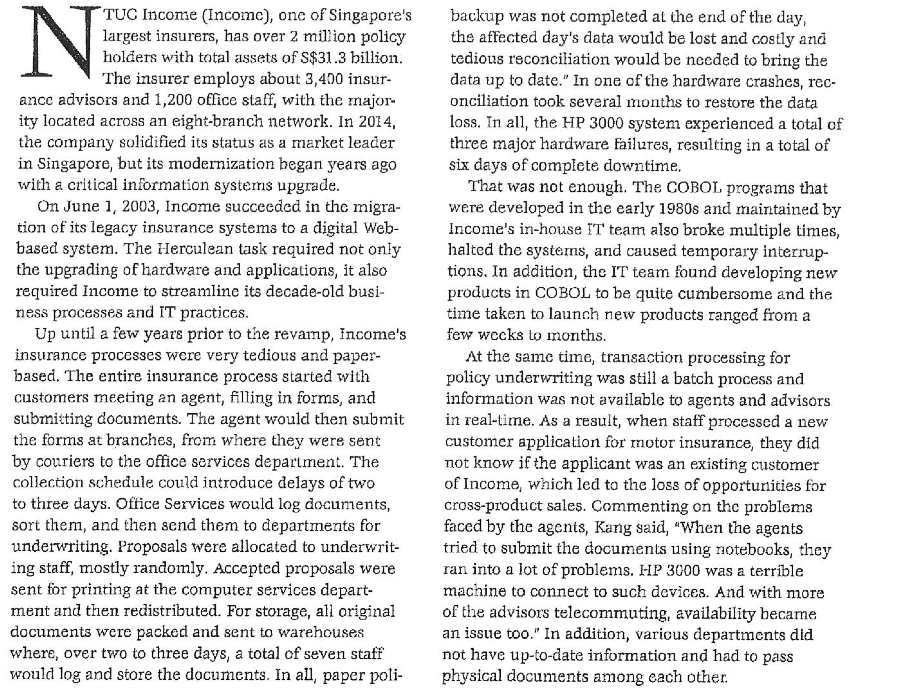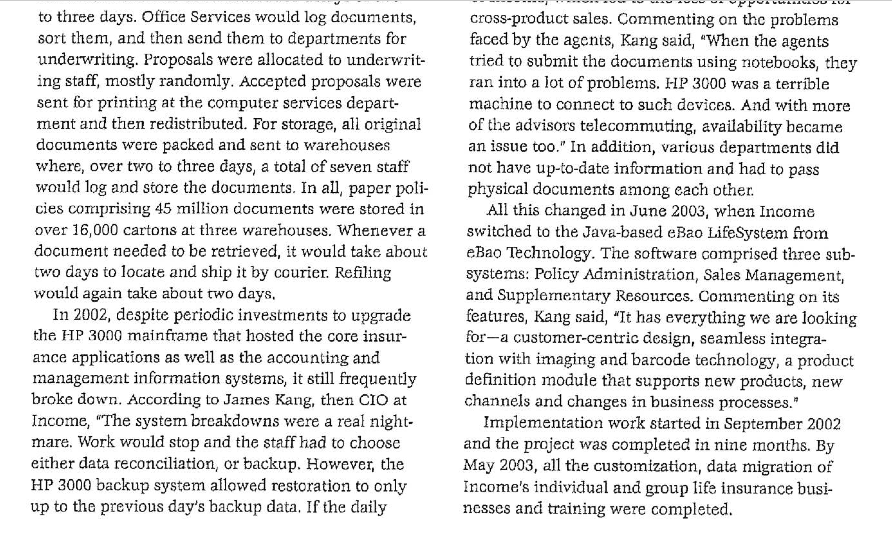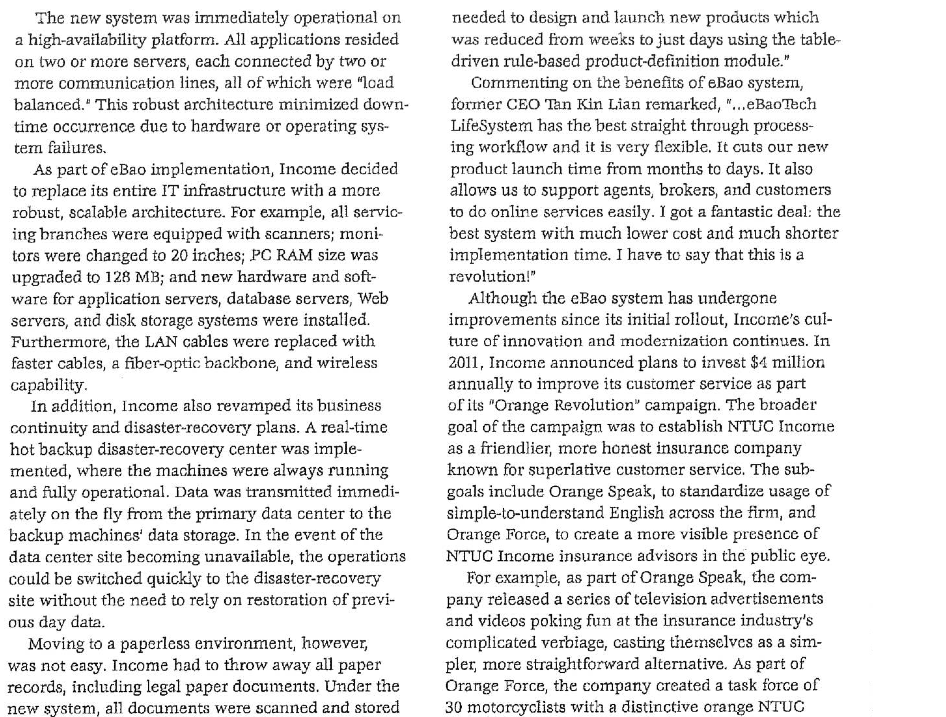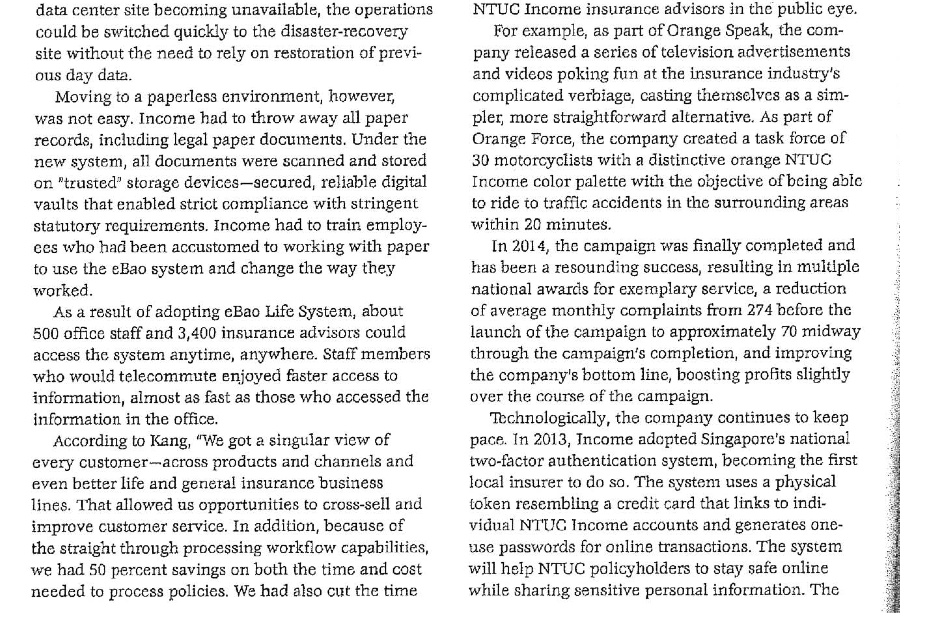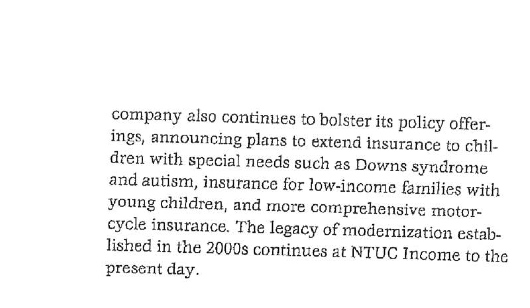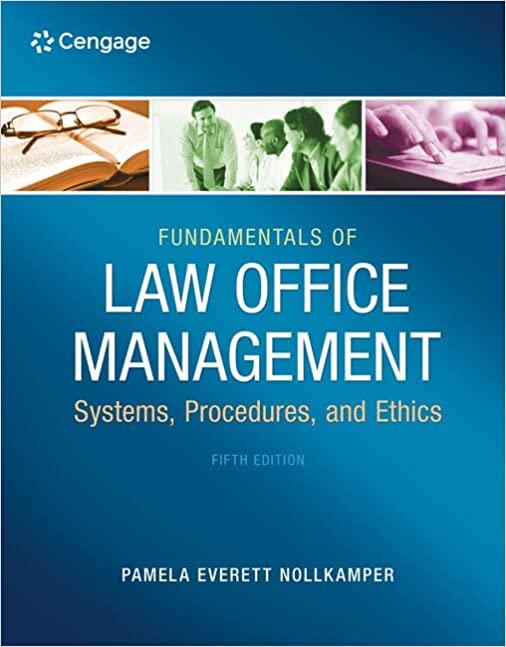Modernization of ntuc income case study
Question
What types of information systems and business processes were used by Income before migrating to the fully digital system?
Question
Describe the Information systems and IT infrastructure at Income after migrating to the fully digital system?
TUE: Income (Income), one of Singapore's largest insurers, has over 2 million frolic;r holders with total assets of S$31 .3 billion. The insurer employs about 3,400 insur- ance advisers and 1,209 office staff, with the majori ity located across an eight-branch network. In 20H, the company solidied its status as a market leader in Singapore, but its modernization began years ago with a critical information systems upgrade. On June 1, 20453, Income succeeded in the migra- tion of its legacy insurance systems to a digital Web based system. The Herculean task required not only the upgrading of hardware and applications, it also roquired Income to streamline its decade-old busi- ness processes and IT practices. Up until a few years prior to the revamp, lncorne's insurance processes were very tedious and paper- based. The entire insurance process started with customers meeting an agent, lling in forms, and submitting documents. The agent would then submit the forms at branches. From where they were sent by couriers to the ofce services department. The collection schedule could introduce delays of two to three days. Ofce Services would log documents, sort them, and then send them to departments For underwriting. Proposals were allocated to underwrit- ing staff, mostly randomly. Accepted proposals were sent for printing at the computer sunrises depart- ment and then redistributed. For storage, all original documents were packed and sent to warehouses where, over two to three days, a total of seven staff\" would log and store the documents. In all, paper poli- bacltup was not completed at the end of the day, the affected day's data would be lost and costly and tedious reconciliation would be needed to bring the data up to date." In one of the hardware crashes, rec- onciliatiort took several months to restore the data loss. In all, the HP 3000 system experienced a total of three major hardware failures, resulting in a total of sis. days of complete douoittme. That was not enough. The COBOL programs that were developed in the early 19803 and maintained by Income's in-house IT team also broke multiple times, halted the systems, and caused temporary interrup- tions. In addition, the IT team found develoPing new products in COBOL to be quite cumbersome and the time taken to launch 11 ow products ranged from a few weeks to months. At the same time, transaction processing for policy underwriting was still a batch process and information was not available to agents and advisers in real-time. As a result, when statl'proccsscd a new mistomcr application for motor insurance, they did not know :it' the applicant was an existing customer of Income, which led to the loss of' opportunities For crossproduct sales. Commenting on the problems faced by the agents, Kong said, \"When the agents tried to submit the documents using notebooks, they ran into a lot of problems. HI? 30013 was a terrible machine to connect to such devices. And with more of the advisers telecommuting, availability became an issue too." In addition, various departments dld not have up-todate information and had to pass physical documents among each other. to three days. Office Services would log documents, cross-product sales. Commenting on the problems sort them, and then send them to departments for faced by the agents, Kang said, "When the agents underwriting. Proposals were allocated to underwrit- tried to submit the documents using notebooks, they ing staff, mostly randomly. Accepted proposals were ran into a lot of problems. HP 3000 was a terrible sent for printing at the computer services depart- machine to connect to such devices. And with more ment and then redistributed. For storage, all original of the advisors telecommuting, availability became documents were packed and sent to warehouses an issue too." In addition, various departments did where, over two to three days, a total of seven staff not have up-to-date information and had to pass would log and store the documents. In all, paper poli- physical documents among each other. cies comprising 45 million documents were stored in All this changed in June 2003, when Income over 16,000 cartons at three warehouses. Whenever a switched to the Java-based eBao LifeSystem from document needed to be retrieved, it would take about eBao Technology. The software comprised three sub- two days to locate and ship it by courier. Refiling systems: Policy Administration, Sales Management, would again take about two days, and Supplementary Resources. Commenting on its In 2002, despite periodic investments to upgrade features, Kang said, "It has everything we are looking the HP 3000 mainframe that hosted the core insur- for-a customer-centric design, seamless integra- ance applications as well as the accounting and tion with imaging and barcode technology, a product management information systems, it still frequently definition module that supports new products, new broke down. According to James Kang, then CIO at channels and changes in business processes." Income, "The system breakdowns were a real night- Implementation work started in September 2002 mare. Work would stop and the staff had to choose and the project was completed in nine months. By either data reconciliation, or backup. However, the May 2003, all the customization, data migration of HP 3000 backup system allowed restoration to only Income's individual and group life insurance busi- up to the previous day's backup data. If the daily nesses and training were completed.The new system was irru'nediately operational on a high-availability platform. All applications resided on two or more servers, each connected by two or more communication lines, all of which were \"load balanced.\" This robust architecture minimized down time occurrence due to hardware or operating sys- tem failures. As part oE'eBao implementation, Income decided to replace its entire 1T infrastructure with a more robust, scalable architecture. For example, all servic- ingbranches were equipped with scanners; moni- tors were changed to 20 inches; PC RAM size was upgraded to 123 MB,- ancl new hardware and sor ware for application servers, database servers, Web servers, and disk storage systems were installed. Furiermore, the LAN cables were replaced with faster cables, 8 ber-optic backbone, and wireless capability. In addition, income also revamped its business continuity and tlissstea'srsocwerg.r plans. A real~me hot backup disaster-recovery center was imple- mented, where the machines were always running and fully operational. Data was transmitted immedi- ately on the fly from the primary data center to the backup machines' data storage. In the event of the data center site becoming unavailable, the operations could be switched quickly to the disaster-recovery site without the need to rely on restoration of previ ous day data. Moving to a paperless environment, however, was not easy. Income harl to throw away all paper records, including legal paper documents. Under the new system, all documents were scanned and storerl nestled to design and launch new products which was reduced from Weeks tojust days using the table driven rule-based product-denition module.\" Commenting on the benets of 63:10 system, former CEO 'Itu: Kin Lian remarked, "...eBao'It:ch LifeSystem has the best straight through process ing workow and it is very flexible. It cuts our new product launch time from mouths to days. It also allows us to support agents, brokers, and customers to do online services easily. I got a fantastic deal: the best system with much lower cost anti much shorter implementation time. I have to say that this is a revolution!\" Although the eBao system has undergone improvements since its initial rollout, lncome's cul- ture of innovation and modernization continues. In 3011, Income announced plans to invest $4 million annually to improve its customer service as part of its "Orange Revolution\" campaign. The broader goal of the campaign was to establish NTUG income as a friendlier, more honest insurance company known for sapsrlative customer service. The sub- goals include Orange Speak, to standardise usage of simpletounderstand English across the thin, and Orange Force, to creme a more visible presence of N'I'UC income insurance advisers in the public eye. For example, as part ofrange Speak, the com- pany released a series of television. advertisements and videos poking fun at the insurance industry's complicated verbiage, casting remeclvcs as a sim- pler; more straightforwani alternative. As part of Orange Force, the company created a task force of 30 motorcyclists with a distinctive orange NI'UG data center site becoming unavailable, the operations could be switched quickly to the disastenrecovery site without the need to rely on restoration of previ ous day data. Moving to a paperless environment, however, was not easy. Income had to throw away all paper records, including legal paper documents. Under the new system, all documents were scanned and stored on \"trusted\" storage deviccswsecured, reliable digital vaults that enabled strict compliance with stringent statutory requirements. Income had to train employ ees who had been accustomed to working with paper to use the alien system and change the way the-:5.r worked. As a result at adopting eBac Life System, about 500 ofce staff and 3,400 insurance advisers could access the system anytime. anywhere, Staff members who would telecommute enjoyed faster access to information, almost as fast as those who accessod the information in the ofce. Aacording to Kong, \"We got a singular view of every customeracross products and channels and even better life and general insurance business lines. That allowed as opportunities to cross-sell and improve customer service. In addition, because of the. straight through processing workow capabilities. we had 50 percent savings on both the time and cost needed to process policies. We had also out the time N'I'UIS Income insurance advisers in the public eye. For example, as part ofrange Speak, the com- pany released a series of television advertisements and videos poking fun at the unsurancc industry's complicated verbiage, casting remeclvcs as a sim- pler, more straightforward alternative. As part of Orange Force, the compacts.r created a task force of 30 motorcyclists with a distinctive orange NTUG Income color palette with the objective of being able to ride to trafc accidents in the surrounding areas within 20 minutes. In 2014, the campaign was nally completed and has been a resounding success, resulting in multiple national awards for exemplary service, a reduction of average monthly complaints from 274 before the launch of the campaign to approximately '70 midway through the campaign's Completion, and improving the company's bottom line, boosting prots align-it];r over the course of' the campaign. 'Ibchnologically, the company continues to keep pace. in 2013, income adopted Singapore's national two-factor authentication system, becoming the rst local insurer to do so. The system uses a physical token resembling a credit card that links to indi- vidual NTUG Income accounts and generates one use passwords for ouline transactions. The sysrem will help NTUC policyholders to stay safe online while sharing sensitive personal information. The \"ill-Irv-l-lu'i'; .v.. _, .-.-. .. _ _ i 2-13.! at ca company also continues to bolster its policy offer- ings, announcing plans to extend insurance to chil- dren with special needs such as Downs syndrome and autism, insurance for low-income families with young children, and more comprehensive motor- cycle insurance. The legacy of modernization estab- lished in the 2000s continues at NTUC Income to the present day
